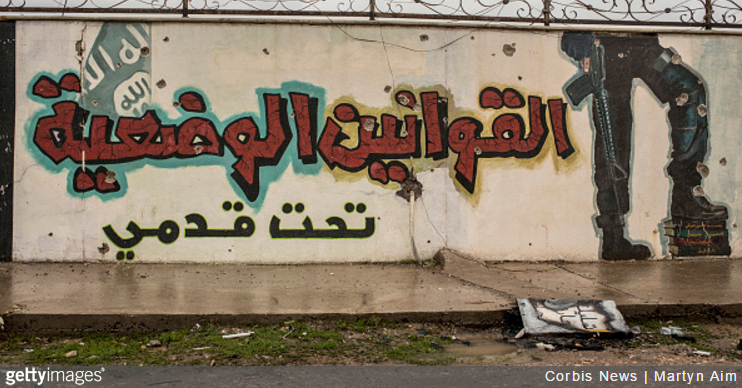In January, the Iraqi government announced it had taken full control of eastern Mosul, the second-largest city in the country – a major victory in its long battle to recapture territory seized by the Islamic State of Iraq and the Levant (ISIL). Although ISIL affiliates continue to pose a threat in other areas around the world, it seems that ISIL is on its way to losing its “caliphate” in Iraq and Syria.
Yet despite ISIL’s losses on the battlefield, the group has been achieving an important ideological goal: the elimination of the “grayzone,” the plane of coexistence between Muslims living in the West and their non-Muslim countrymen.
To ISIL and its supporters, Muslims who live in the West and other non-Muslim majority regions are a threat to their narrative and recruiting goals. ISIL sees the world as being divided between the world of unbelief (or “kufr”) and the world of “Islam” – that is, areas under the rule of ISIL. Between these worlds lies a “grayzone” inhabited by Muslims not affiliated with ISIL.
According to ISIL, Muslims residing in this zone live in a state of hypocrisy and apostasy. After all, an important part of the group’s discourse is that ISIL is fighting “on their behalf” against the enemies of Islam. Muslims in the grayzone also represent a threat to the organization: While ISIL has tried to portray its caliphate as an Islamic utopia, the overwhelming majority of Muslims has responded with condemnation and mockery.
Terrorism analysts like Jessica Stern have argued that eliminating the grayzone could be as important to ISIL as maintaining the caliphate and confronting the West in an apocalyptic battle in Syria. Perhaps no other recent event was as useful to ISIL as the election of Donald Trump as president of the United States. During the 2016 campaign, reports emerged that supporters of the so-called caliphate preferred the firebrand leader to prevail. When Trump won, many of these extremists celebrated his win, seeing him as the perfect enemy: a populist who employs toxic rhetoric against Muslims, both those in the United States and elsewhere. While ISIL has officially not commented on Trump’s policies, terrorism analyst Charlie Winter has suggested that the vision behind this is simply “they can let the car crash by itself.”
Trump’s recent moves to ban refugees and immigrants from six Muslim-majority countries has only played into this. Despite the ban’s unconstitutionality, racist purpose, and lack of security benefits, the Trump administration shows no signs of backing down.
Although it is highly unlikely that these developments will cause Muslims to become radicalized en masse or ally with ISIL, Trump’s policies provide fuel for ISIL’s attacks on the grayzone. Many ISIL recruits are Western Muslims who are unsure of their place in European societies, who feel discriminated against by their countrymen, and who often face other problems as well. The recent attacks in Paris, Brussels, and Orlando serve to increase suspicion and hatred among non-Muslims toward their Muslim compatriots, and lead to the election of politicians using anti-Muslim rhetoric.
Many of these attacks were carried out by Western nationals who had pledged allegiance to ISIL, a fact that only served to deepen suspicion of Muslims. While these brutal attacks had little tactical value for ISIL’s war in Iraq and Syria, they did succeed in increasing tensions between Western societies and their Muslim citizens. Examples include France’s burkini ban, the rise in hate crimes against Muslims and other minorities in the United Kingdom post-Brexit, and the hesitance of many countries to take in refugees fleeing the horror created by the Assad regime and ISIL.
These actions, ISIL hopes, will cause Muslims to believe they do not have a place in these societies, and then swear allegiance to the Islamic State. The Islamic State’s English-language magazine Dabiq makes this clear: “The Muslims in the West will quickly find themselves between one of two choices … apostatize and adopt the kufri [non-Islam] religion … or perform hijrah [migration] to the Islamic State and thereby escape persecution from the crusader governments.”
The problematic political discussion of Muslims in the United States has not helped matters. The presidential campaigns and debates made clear that American Muslims could only be viewed through the prism of security: as threats, according to Trump, or as tools against ISIL, as described by Hillary Clinton.
The message came through loud and clear: Muslims only had a place in our plural society according to the expectations set by white America or Europe. Although this was already a troubling narrative in our discourse, today the United States has a leadership that has exchanged the dog whistles for out-and-out bigotry. Unfortunately, the rise of similar Trump-style politicians in Europe seems possible. Although the far-right candidate Geert Wilders was defeated last month in the Dutch parliamentary elections, France and Germany will go to the polls in closely watched elections later this year.
If ISIL intends to fracture societies by eliminating the grayzone, it seems we may be helping them to achieve this goal.
